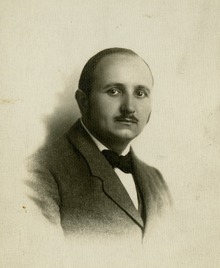Michael Somogyi
Michael Somogyi (born March 7, 1883 in Zsámánd , Felsőőrvidék , † July 21, 1971 in St. Louis ) was a Hungarian-American biochemist . He was best known for his work on diabetes mellitus and discovered the Somogyi effect, which is now named after him, in 1938 .
Life
Somogyi studied chemistry at the University of Budapest until 1905 and then went to the United States of America. After initial difficulties in finding a job, he got an assistant position for biochemistry at the Medical College of Cornell University , where he worked until 1908. He then went back to Budapest and became the chief chemist of the city laboratory. In 1914 he was awarded a doctorate by the University of Budapest. In 1922, his former Cornell University colleague, PA Schaffer , persuaded him to return to the United States to teach biochemistry at the Washington University Medical School in St. Louis . In 1926 he became chief chemist at the Jewish Hospital in St. Louis , where he worked until his retirement in 1957. In 1926 he developed a method for determining blood sugar levels . From then on he was particularly interested in diabetes mellitus . In 1938, at a congress, he first presented the theory that insulin therapy itself can trigger unstable diabetes. In 1940 he developed a method for determining serum amylase .
Somogyi died of a stroke in 1971 .
Web links
- Michael Somogyi at whonamedit
| personal data | |
|---|---|
| SURNAME | Somogyi, Michael |
| BRIEF DESCRIPTION | Hungarian-American biochemist |
| DATE OF BIRTH | March 7, 1883 |
| PLACE OF BIRTH | Zsámánd , Felsőőrvidék |
| DATE OF DEATH | July 21, 1971 |
| Place of death | St. Louis |
